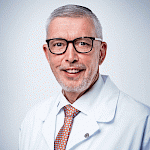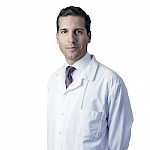Causes
Most cataracts are age-related. However, they may also have other causes such as metabolic diseases, other eye diseases or eye injuries.
Age-related cataracts
Normally, the lens of an eye is clear and can be deformed as required by the muscles of the eyes. This deformability, together with the fluid surrounding the lens, enables us humans to see both at a distance and nearby with equal clarity. The medical term is accommodation of the eye, i.e. the ability of the eye to adapt to objects at different distances. The older you get, the less flexible your lens will be, which can cause it to become cloudy. For this reason, the vast majority of cataracts are “age-related cataracts,” which can occur from around the age of 60. However, there are a lot of people who suffer from cataracts without being aware of it as there is often no visual disturbance at the beginning of the illness.
Metabolic disorders
If you are diabetic, the sugar content in the aqueous humour in your eyes (and of course also in your blood) is naturally higher. The excess sugar is deposited in the lens of the eye, which swells up as a result. This in turn causes the arrangement of the lens fibres to shift, making the lens cloudy. Doctors refer to this form of cataracts as “diabetic cataract”.
In addition, there are other metabolic disorders that can lead to cataracts. Specifically, these are calcium deficiency, hyperactivity of the parathyroid gland, excess ferritin (known as iron-storage protein) in the blood or galactosaemia, a congenital problem with utilising the sugar contained in breast milk (galactose).
Eye diseases and injuries
Cataracts can also be caused by other eye diseases. The technical term for these types of cataracts is “complicated cataract”. Inflammation of the eyes or extreme short-sightedness can be a trigger for this. Contusions of the eyeball or a deep injury to the eye can also cause cataracts (known as traumatic cataract).
Congenital eye malformation
Cataracts can also be congenital (congenital cataract), which are either due to a genetic defect or to infectious diseases of the mother during pregnancy. Genetic defects can lead to a malformation of the eye and thus to clouding the lens of the eye and cataracts; in addition, certain infections in pregnant women – such as herpes, rubella or toxoplasmosis – can lead to the birth of a baby with cataracts.
Other causes
In addition, heavy smoking, malnutrition, radioactive radiation, UV light or lens metabolism defects can cause cataracts. And in rare cases, even medication or poisoning can cause the lens of the eye to become cloudy and result in loss of vision.










